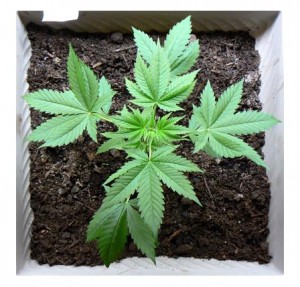
Hydroponic nutrients are high-quality formulations that are water soluble, contain all of the necessary nutrients, and leave no impure residues in the reservoir bottom is best how to grow marijuana indoors.
High-quality fertilizer formulas are packed in one (1), two (2), or more (+) part formulas when growing marijuana indoors and outdoors.
Control over nutrients is easier when using pure high-grade nutrients than compared to lower-quality formulations when learning how to grow medical marijuana.
The best way how to grow marijuana is like all other plants because they need nutrients to grow, live and thrive. Nutrients must be broken down chemically within the cannabis plant so it is always best to use high-quality nutrients that are natural and organic fertilizers.
Nutrients that are made from chemicals will work to grow your plants, but the product will not be organic and can leave a chemical taste in the buds if they are not properly flushed out.
Using Nutrient Solutions

To avoid nutrient problems in your systems it is good to change nutrient solutions within the reservoir every one (1) week. Your plants will absorb nutrients at different rates so some of the plants will run out of nutrients before others when learning how to grow marijuana indoors.
If you are reserved to use enough nutrients in your indoor system when you are learning how to grow marijuana then you can have stunted plants as a result. Hydroponics provides the means to supply the maximum amount of nutrients a plant needs throughout their lives.
Remember, that hydroponic system are designed for high performance if a single component malfunction in your system then problems can occur very fast and could result in pH fluctuations, and high nutrient levels or kill your plants.
Solution Maintenance
Plants utilize more water than nutrients when growing so the water levels need to be kept high and balanced within the system. Top off the nutrient solution with 500 – 700 parts-per-million (PPM) strength every few days if your system requires it.
Never let nutrient solution go for more than four (4) weeks before draining it and replacing it with your system. Always check the Electrical Conductivity (EC) of the reservoir, growing medium, and runoff nutrient solution to ensure accurate readings.
Use Hydro-Organic Nutrients

Hydro-organic is meant learning how to grow medical marijuana in an inert soilless growing medium and feeding your plants with a soluble organic nutrient solution.
This means no chemicals whatsoever are introduced into the system or even the growing environment such as pesticides and herbicides like how to grow marijuana outdoors.
Using natural nutrients will bring out a sweet organic taste in buds, but organic nutrients are not always able to be broken down fast enough during the plant’s life cycle.
You should be sure to use organic nutrients that are readily available for your plants to get the maximum growth from your crop when learning how to grow marijuana outdoors.
A balance of organic nutrients is achieved with constant experimentation and attention to your garden and system. Taking accurate Electrical Conductivity (EC) reading or mixing exactly the right nutrients is most times more difficult in organic hydroponics.
Organic nutrients have a complex structure and measuring the content within your system is at times difficult. Combining pre-mixed soluble organic fertilizers with other organic ingredients to make a blend will give your plants what they need and great production.
Using soluble organic fertilizers makes it easier to flush from a growing medium when growing marijuana indoors. Organic nutrients at times require heavier flushing if they are not water soluble so growers must flush with plain water for the last two (2) weeks of flowering to get all fertilizers out to produce a good taste.
| Element | PPM Range Limits | Average PPM |
| Nitrogen | 150 – 1,000 | 250 |
| Calcium | 100 – 500 | 200 |
| Magnesium | 50 – 100 | 75 |
| Phosphorus | 50 – 100 | 80 |
| Potassium | 100 – 400 | 300 |
| Sulfur | 200 – 1,000 | 400 |
| Copper | 0.1 – 0.5 | 0.05 |
| Boron | 0.5 – 5.0 | 1.0 |
| Iron | 2.0 – 10.0 | 5.0 |
| Manganese | 0.5 – 5.0 | 2.0 |
| Molybdenum | 0.01 – 0.05 | 0.02 |
| Zinc | 0.5 – 1.0 | 0.75 |
Let us know what you think.



Responses